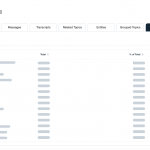5 Ways Workforce Management Can Save You Money
5 Ways Workforce Management Can Save You Money

As a contact center leader, you need to consistently meet customer service expectations while staying within budget. A key factor in achieving both objectives is effective workforce management (WFM) solutions. After all, these resources account for a significant part of your contact center’s full operating budget and are key customer satisfaction drivers. It stands to reason that how you forecast, schedule, and manage them can make or break your contact center budget.
But these are challenging tasks. That’s why WFM forecasting and scheduling cause the majority of contact center budget woes. To do forecasting and scheduling well, analysts must accurately predict the workload. Then, they need to create schedules that put the right contact center agents in the right place and time. This is essential managing the service-level target at any given time throughout the day.
The traditional, manual approach—which is still largely used today—rarely yields the right balance. Often, contact centers struggle with overstaffing or understaffing. The last thing you want is to waste the budget or not meet customer expectations. Let’s explore how to avoid those issues and save your bottom line.
5 Ways to Save Money with Workforce Management Software
That’s why WFM software is designed to deliver a superior customer experience in a reliable, consistent, efficient manner—is quickly gaining steam. It helps supervisors better manage and monitor contact center employees, it makes agents feel more empowered and it motivates both groups to become more proactive.
By focusing on forecasts and schedules, WFM solutions can deliver immediate cost savings to your bottom line in five key ways, such as:
- Reduced agent overstaffing
- Improved agent adherence
- Improved supervisory efficiency
- Reduced agent overtime expenses
- Reduced agent turnover/churn
Let’s explore some top ways that a workforce management solution can help you save money for your contact center.
Money Saver #1: Reduced Agent Overstaffing
With the streamlined task automation provided by WFM software, contact centers can reduce agent overstaffing. It works by reducing the time it takes to forecast, schedule, and manage service levels by 25%. It works for multiple channels and locations as well.
This automation also leverages historical data to deliver more accurate forecasts. All of this results in less overstaffing and less budget over-spend.
Money Saver #2: Improved Agent Adherence
Contact center leaders employing workforce management leverage a variety of capabilities to increase and encourage agent adherence. They empower agents to actively participate in the scheduling process via WFM self-service capabilities.
This enables them to solicit their preferred schedules, easily swap schedules, and request time off. This approach saves time and money for analysts, too. They simply set up an auto-approval workflow framework once in the WFM tool. After that, they can let the system do the work.
Contact center leaders also use WFM to optimize adherence. They can do this by automatically sending alerts or posting schedule updates to agents’ calendars. They’re also able—via visual indicators on WFM dashboards—to spot and address adherence violations more quickly than with manual solutions.
This feature allows leaders to minimize the negative impact on the customer experience. Some workforce management tools even allow agents to view their own adherence status, to encourage adherence self-management.
Money Saver #3: Improved Supervisory Efficiency
Contact centers using WFM also enjoy improved supervisory efficiency. Supervisors can quickly create an accurate, detailed daily forecast using factors such as historical volume information, mathematical algorithms, and simulation methods. This ensures they have the right number and level of agents on call to answer customer inquiries.
With workforce management software, supervisors also can leverage automation to quickly and easily approve agent requests. These can include PTO or vacation requests while also taking into account agent preferences for the schedule.
In addition, WFM lets supervisors and agents more easily monitor key performance indicators (KPIs). These include “first call resolution” and “call times.” By tracking KPIs, leaders can better measure the health and quality of their customer service offerings.
Money Saver #4: Reduced Agent Overtime Expenses
Automating and clarifying contact center forecasting, strengthens the contact center. These WFM tools enable contact center leaders to run forecasts more frequently and accurately, reducing the budget and overtime.
Some tools even predict during which hours the biggest needs will occur. Supervisors can then address any unexpected surges in call volume by quickly and easily shifting resources from less important tasks.
Contact center leaders also can permit agents to leverage WFM self-service features. This can include swapping hours, identifying times they’re available for additional hours, and noting overtime.
Money Saver #5: Reducing Agent Turnover and Churn
Agent turnover is a prevalent, expensive issue in today’s contact centers. And one of the primary reasons agents leave is because they don’t receive consistent feedback and coaching. A WFM tool can alleviate this issue by helping supervisors more easily schedule coaching sessions with agents.
Workforce management tools also can help reduce agent churn by increasing morale. For example, supervisors can reward top performers by letting them have first dibs at prime schedules or shifts. This gives agents control over their own schedules. It also empowers agents to monitor their own performance metrics. Plus, WFM solutions deliver fast, automated approvals on schedule swap and vacation requests.
Some contact centers can also evolve their philosophies regarding schedule flexibility. They might transition a portion of their staff to part-time schedules, offer at-home agent opportunities, or allow more overtime.
Take Your Workforce Management to the Next Level
The future of improved contact centers is here. The best way to empower your agents to provide exceptional customer service is with better technology. Workforce management software enables contact centers to prevent overstaffing, understaffing, agent churn, and so much more. Have more questions about workforce management solutions? Check out our Guide to Workforce Management.









